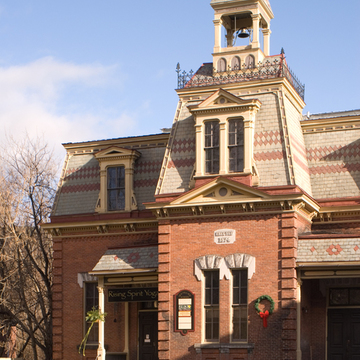You are here
Old Village School (Wells River Graded School)
This Second Empire schoolhouse, rare in Vermont, is based on a published source—plates 7 and 13 of Samuel Eveleth's Schoolhouse Architecture (1870). As a graded school with multiple rooms dispersed across a symmetrical plan, it was more elaborate than contemporary district schoolhouses. Twin doors give into a vestibule, stairwell, and cloakrooms across the front and two large metal-ceilinged classrooms across the back. Described as “light and airy” when it opened, the school has clustered windows in its end elevations. A basement largely exposed by a sloping site and a second floor within the steep mansard make it surprisingly spacious for its modest height and footprint. The school's richly patterned and detailed exterior combines brick, Ryegate granite, polychrome slate, and cast iron. Red and gray slates are laid in patterns on the mansard, twin entrance porches, and the pyramidal cap of the central square belfry. The result is a jewel-like example of its style that served the educational needs of its community for a century before conversion for office use in the 1970s.
Writing Credits
If SAH Archipedia has been useful to you, please consider supporting it.
SAH Archipedia tells the story of the United States through its buildings, landscapes, and cities. This freely available resource empowers the public with authoritative knowledge that deepens their understanding and appreciation of the built environment. But the Society of Architectural Historians, which created SAH Archipedia with University of Virginia Press, needs your support to maintain the high-caliber research, writing, photography, cartography, editing, design, and programming that make SAH Archipedia a trusted online resource available to all who value the history of place, heritage tourism, and learning.















